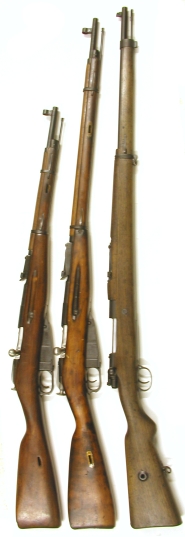 If you get beyond the Sunday paper’s sports section and/or comics, you may have encountered one of the insert ads for inexpensive military surplus firearms. They are typically under $100 and frequently of Turkish, German, Yugoslavian, Russian or Swiss origin. They are sourced from an almost endless list of countries emptying their arsenals of WWII era and earlier rifles. Generally sound, the firearms run from those designed for sub 35,000 PSI cartridges like the Schmidt-Rubin K31, to the beefy and potentially able to handle modern cartridge pressure like the Mosin Nagant and Model 1898 Mauser pieces. Collectively, they are butt ugly, but the look grows on you…sort of like fungus, and at about the same rate.
If you get beyond the Sunday paper’s sports section and/or comics, you may have encountered one of the insert ads for inexpensive military surplus firearms. They are typically under $100 and frequently of Turkish, German, Yugoslavian, Russian or Swiss origin. They are sourced from an almost endless list of countries emptying their arsenals of WWII era and earlier rifles. Generally sound, the firearms run from those designed for sub 35,000 PSI cartridges like the Schmidt-Rubin K31, to the beefy and potentially able to handle modern cartridge pressure like the Mosin Nagant and Model 1898 Mauser pieces. Collectively, they are butt ugly, but the look grows on you…sort of like fungus, and at about the same rate.
A little strange to handle, they of stick to you, figuratively and literally; all that history, under all that oil and varnish, with metal parts finished in bluing that looks a lot like gloss black paint and lots of Cosmoline preservative. They are stout, can be used as a club in a pinch and are a lot more interesting than a garden variety synthetic stocked $2,000 bolt gun. Handle one for a moment or two and you can’t help but think of its potential; restore it, clean it up and shoot it, refinish it, take it hunting, or overhaul and modernize until it becomes another boring bolt gun. I was in the midst of this type of mental dilemma, feeling indecisive, so I purchased three military surplus firearms – (left to right) two Russian Mosin Nagants, a Model 38 carbine and a Model 91/30 rifle and one 1938 Turkish Mauser. The Mauser fell victim to refurbishing as a shooter, the Nagants remain intact with their futures TBA.
I’ll refrain from parroting the detail history of these firearms. This is covered ad nauseam elsewhere, sometimes not so well and sometimes with much greater accuracy than I could ever muster. “The Mosin-Nagant Rifle” by Terence W. Lapin has the most detailed historical information of any sources I’ve uncovered. The7.62x54r.net site is an exceptional resource, as is Mosin-Nagant.Net. For the military surplus Mauser crown, there is “Mauser Military Rifles of the World, 3rd Edition” by Robert W. D. Ball, an excellent source for detailed and historical perspective. “The Mauser M91 through M98 Bolt Actions” by Jerry Kuhnhausen is the best source for information addressing operation and the detailed mechanics of these firearms. I don’t have a particular web site for accurate reference, many have gone the way of most gun magazines, presenting articles that are no more than thinly disguised infomercials for their advertisers. Message board discussion runs from dead accurate and concise to idiotic, erroneous and overbearing.
My focus is on each guns very basic specs as they relate to use, the handloading of their respective cartridges and assessment of the general performance of the combination. Where each gun has some unique aspect that unexpectedly surfaced either while tinkering with the mechanical parts, handloading or shooting the firearm. I tried to note each instance within the section dedicated to each rifle below. Specifically, my interest is that these low cost firearms can offer a great opportunity for people to inexpensively learn or develop hunting, shooting, gun tinkering or handloading skills.
Model 38 Mosin Nagant

|
Model 38 as purchased |
|
| Year Produced | 1944 |
| Overall Length | 40″ |
| Barrel Length | 20 1/4″ |
| Weight | 7 3/4 lbs |
| Trigger pull weight | 8 lbs 7 oz |
| Active trigger pull length | .375″ |
| Cartridge | 7.62x54R |
| Bullet Diameter | .311″ |
This particular rifle has all matching serial numbers and was manufactured in 1944 at the Izhevsk arsenal. The gun has a laminated birch stock with a toe slice, a practice that permitted the Soviets to economize by allowing the use of more narrow stock blanks, salvaging substandard blanks or repairing defective stocks. Like most things, various sources advance various opinions. The Model 38 feels a lot smaller than it’s actual size and weight. The stock’s pull is 13 1/2″ compared to 13 1/4″ for a new Winchester Super Shadow and only 1/8″ shorter than a full size Weatherby. Still, shooting it feels like pointing a short 2×4 piece of lumber. The bolt handle is located inside the ejection port area of the receiver, rather than behind, placing it a full 16 1/2″ forward of the heel of the stock, approximately 2″ farther forward than a typical Remington Model 700. The rear sight appears to be located far forward also, but this is an optical illusion perhaps brought on by the relatively short barrel. The rear sight is 23″ from the heel of the stock, the same as the Model 700 Remington.
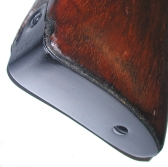
I’m not a big girl, I shoot a lot of over .400″ bore rifles that most people would suggest kick like the proverbial mule, but this little gun smacked the crap out of me. It could be the steel butt plate as the width at 1 1/2″ is pretty typical, or it could be the short height of only 4″, about an inch less than most sporting rifle, that puts the heel right into the shoulder muscle when shooting from a bench. Muzzle blast is notable, muzzle rise is minimal; the drop at the heel is 1 1/2″, designed to bring the gun mostly straight back on discharge. A note on loading – The only problem I had with operation was feeding from the magazine. The key is to always insert the new round with its rim ahead of the preceding round and don’t force rounds down too deeply into the magazine or they may become entangled with the ejector/interrupter and not feed upward.
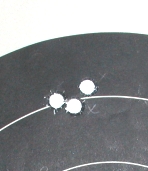
This is a three shot group at 50 yards with open sights, shooting off of sandbags. Winchester 180 grain Metric Calibers ammo shot like this all day. I am normally bad with metallic sights because of my computer monitor eyesight, but the thin blade of the military sight offered a great sight picture and the gun is very easy to hold steady.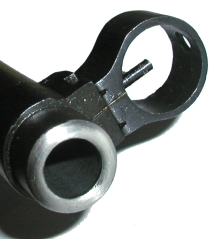 The front sight pin does not fill the notch in the rear sight, so it is possible to see the front sight critically aligned to the rear sight, while still being able to clearly see the target down range. I would not like to use these sights at low light levels.
The front sight pin does not fill the notch in the rear sight, so it is possible to see the front sight critically aligned to the rear sight, while still being able to clearly see the target down range. I would not like to use these sights at low light levels.
You can probably see there is no rifling at the muzzle, the gun has been counterbored to remove shot out or damaged rifling and the muzzle has been recrowned. This unrifled area is approximately 1″ in length, making the rifle’s velocity performance even more impressive as there is only 17.3″ of active barrel after the chamber.
I was able to slug the bore and came up with somewhere between .311″ – .312″ groove diameter. I would not attempt using a .312″ bullet, but .310″ would not be too sub diameter.
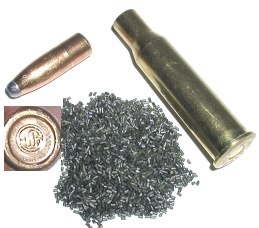 I don’t know what type of powder Winchester uses in these loads, but I have to assume it is relatively fast. The 20″ barrel gun averaged a chronograph verified 2,468 fps, the 24″ barrel rifle 2,523 fps. 55 fps isn’t much to write home about for 4″ more barrel. The factory ammo contained 47 grains of a very familiar short extruded powder with a green cast. The gun’s bore is .311″, which offers a limited bullet selection for reloading, however, all is not lost because .310″ seems to work as well.
I don’t know what type of powder Winchester uses in these loads, but I have to assume it is relatively fast. The 20″ barrel gun averaged a chronograph verified 2,468 fps, the 24″ barrel rifle 2,523 fps. 55 fps isn’t much to write home about for 4″ more barrel. The factory ammo contained 47 grains of a very familiar short extruded powder with a green cast. The gun’s bore is .311″, which offers a limited bullet selection for reloading, however, all is not lost because .310″ seems to work as well.
Bullets pulled randomly from Winchester factory rounds checked .310″, not a .311 in the bunch. I also noticed what looks a lot like a Sellier-Bellot logo engraved on the heel of the bullet. Winchester rates their 180 grain 7.62x54R loads at 2,579 fps. Sellier-Bellot lists a 174 grain load at 2,974 fps. 47 grains of Reloder 15 will deliver the 2,460 range at approximately 46,000 PSI. 50.6 will take the pressure to just about the CIP MAP limit of 56,564 PSI, and deliver 2,650 fps out of the short barrel. The long barrel will add approximately 100 fps over the carbine with this powder. The 7.62x54R has about 4 more grains capacity than the 308 Winchester, but its maximum pressure rating is about 4,000 PSI less. I don’t think either cartridge is designed to perform its best with a 180 grain bullet. A 150 grain bullet can be driven to over 3,000 fps out of the short barrel version, and that’s a pretty effective deer combination. You can go faster if you go lighter, the 125 grain range, but 3,100 fps out of a short barreled gun isn’t exactly a varmint rifle. For that matter, either is 3,300 fps out of the long barrel rifle.
I would take this gun deer or boar hunting almost anytime where ranges are 100 yards and under. It is light, powerful and stout. I would not, under any circumstances, ruin the gun by sticking on a cheap synthetic stock, or a screw on bolt handle or a kludge “scout” scope mount. These custom approaches remind me of years long gone by when people could not accept you could sporterize a Mauser or an ’03 Springfield, but you could never sporterize a British Enfield. Some guns are just ugly and that is where you will see the beauty of their design.
Model 1891/30 Mosin Nagant

|
Model 91/30 as purchased |
|
| Year produced | 1943 |
| Overall Length | 48 1/2″ |
| Barrel Length | 28 3/4″ |
| Weight | 8 3/4 lbs |
| Trigger pull weight | 7 lbs 15 oz |
| Active trigger pull length | .625″ |
| Cartridge | 7.62x54R |
| Bullet Diameter | .311″ |
This is another all matching number gun, but it is obvious from the finish under the bluing it did not lead as comfortable a life as the carbine. Made at the Tula Soviet arsenal in 1943, headspace was good, but the bore is not stellar and this condition manifested itself when the gun printed 50 yard shotgun pattern like groups. The barrel is not counterbored, the rifling is distinctive, but the bore appears to be heavily pitted. A good reason to bring something up to run through the bore when examining these guns for purchase. The extra weight made it easier to shoot from the standpoint of reduced felt recoil, however, it is still a gun built for utility and not for shooter comfort.
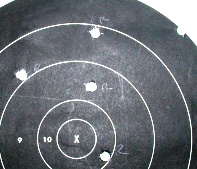 While the carbine was a great shooter, the 91/30 went to the opposite end of the spectrum. This was pretty typical with a 4 1/2″ extreme spread for 5 shots. I think the best three shot was 3 1/2″ and inconsistent. I won’t give up on the gun. I may be able to spend more time cleaning up the bore, I may be able to optimize handloads to squeeze this down a bit. I don’t like to have guns around that can’t shoot. In all other respects there was noting noteworthy that would differentiate it from the carbine, other than the spike bayonet that came packed along with the gun’s other accessories. Model 38’s did not have a bayonet. Both of the Russian guns came with ammo pouches, oiler, web slings, bolt tools, etc. Makes for an interesting package and a little more of a story to tell.
While the carbine was a great shooter, the 91/30 went to the opposite end of the spectrum. This was pretty typical with a 4 1/2″ extreme spread for 5 shots. I think the best three shot was 3 1/2″ and inconsistent. I won’t give up on the gun. I may be able to spend more time cleaning up the bore, I may be able to optimize handloads to squeeze this down a bit. I don’t like to have guns around that can’t shoot. In all other respects there was noting noteworthy that would differentiate it from the carbine, other than the spike bayonet that came packed along with the gun’s other accessories. Model 38’s did not have a bayonet. Both of the Russian guns came with ammo pouches, oiler, web slings, bolt tools, etc. Makes for an interesting package and a little more of a story to tell.
Even if this was a good shooter, it would still remain a display piece, maybe seeing a day or two at the range. It is the Model 38 without the fun or utility and certainly as ugly, again, “ugly” as a term of endearment. It is too long, too heavy…and too long. For handload development it is cheap access to a 24+” barrel to compare powder burn with a short gun. If you drink beer and have idiot friends, it might also make for some interesting Saturday night bayonet drill.
Model 1938 Turkish Mauser

|
Model 1938 Turkish after refurb |
|
| Year produced | 1938* |
| Overall Length | 48 3/4″ |
| Barrel Length | 29 1/10″ |
| Weight | 9 lbs |
| Trigger pull weight | 9 lbs 10 oz |
| Active trigger pull length | .725″ |
| Cartridge | 8x57mm IS |
| Bullet Diameter | .323″ |
| Note* – The gun was reworked in a Turkish arsenal in 1938. It was an original German Infantry Model 1898 (GEW) probably produced after 1905 and prior to 1915 based on hardware and stock configurations. | |
The stock configuration is a bit different from the Russian firearms. The pull is only 13″, shorter than the Russian carbine. The drop at the heel is 1 3/4″, a bit more than the Russian rifles. The steel butt place is a little wider and higher, 2″ and 4 1/2″ respectively – which did not make a damn bit of difference to shooter discomfort over the Russian rifles. My guess is these countries wanted their soldiers in a state of perpetual anger and aggravation to better serve their mission. This is of course my “shame gun” as I reblued the metal parts, corrected problems and refinished the stock in opposition to collectors advice everywhere. Still, I like it a lot.
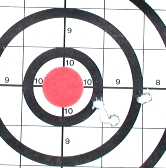
I am, how can I describe this…computer monitor blind. I am far sighted so metallic sights for anything other than decoration are typically a thing of the far distant past. Give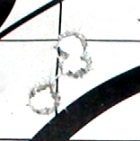 me a scope and I can hit just about anything. Unfortunately, none of these military firearms have to capacity or utility to mount a scope. Still, this is a 1.250″ 50 yard 5 shot group that is routine for this gun, and three shot groups routinely came in under 1/2″ as pictured right. In a tight schedule to get back to work, the barrel was almost too hot to touch, but the gun performed admirably regardless handload powder charges, bullet type and bullet weight. In fact, at one point I fired 30 consecutive rounds of differing bullet weight, charges, and powder type, moving the rifle off target frequently and not making any adjustment to sights; all fell within 2 1/2″ of one another, again with open sights at 50 yards and my less than hawk like eyesight. Neato.
me a scope and I can hit just about anything. Unfortunately, none of these military firearms have to capacity or utility to mount a scope. Still, this is a 1.250″ 50 yard 5 shot group that is routine for this gun, and three shot groups routinely came in under 1/2″ as pictured right. In a tight schedule to get back to work, the barrel was almost too hot to touch, but the gun performed admirably regardless handload powder charges, bullet type and bullet weight. In fact, at one point I fired 30 consecutive rounds of differing bullet weight, charges, and powder type, moving the rifle off target frequently and not making any adjustment to sights; all fell within 2 1/2″ of one another, again with open sights at 50 yards and my less than hawk like eyesight. Neato.
I’m very tempted to buy another Turkish Mauser and make it into an early European sporting rifle look alike with a full length hog’s back stock, 9mm something cartridge, double set triggers, etc. Even if I don’t, I may take this unwieldly piece of pipe out hunting and shooting, much like my muzzle loader. It’s fun to shoot and it is a well made gun, however, in actuality, it will probably find a spot next to the 30 Mosin rifle as too big to be practical in most settings outside of the range.
Lots more left to do for Part II
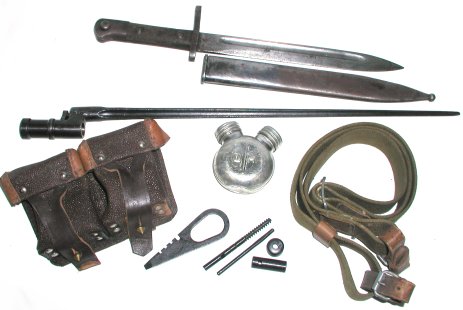
The rifles came with lots of accessories; bayonets, oilers, cleaning kits, slings, disassembly tools, etc. These have all been cleaned, bagged and tagged for future reference.
I have completed handloading for both cartridges, but still need to gather my notes, pictures and put together some cohesive data tables for publication. To me, this was another interesting part of the exercise.
Preface to Reloading and Part II
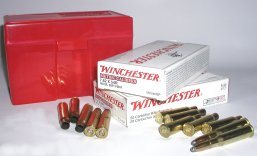 Buyers of these firearms are not left stranded without ammo, both cartridges have factory loads as well as component parts. The 7.62x54R takes a little creative component bullet selection that should be preceded with slugging the individual gun’s bore. Shopping around is essential. Personally, I wouldn’t put real military surplus ammo through any gun of this type for fear of getting corrosive material that would damage the firearm in the absence of special and immediate post shooting attention. Having shot and cleaned black powder firearms I can say it is not a casual process, and immediate cleaning is essential.
Buyers of these firearms are not left stranded without ammo, both cartridges have factory loads as well as component parts. The 7.62x54R takes a little creative component bullet selection that should be preceded with slugging the individual gun’s bore. Shopping around is essential. Personally, I wouldn’t put real military surplus ammo through any gun of this type for fear of getting corrosive material that would damage the firearm in the absence of special and immediate post shooting attention. Having shot and cleaned black powder firearms I can say it is not a casual process, and immediate cleaning is essential.
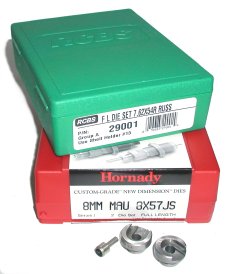 Prices for ammo are all over the place – 7.62x54R ammo from Norma is $35.00/20. You can find Barnaul ammo for about $5/20, if you don’t mind steel cases non-corrosive Berdan primers, but an inability to reload the cases. Unloaded and unprimed Norma brass is $20/20, so I bought Winchester white box boxer primed 180 grain soft point bullets for only $12/20. The Winchester brass can be reloaded and is non-corrosive. The 8x57mm JS premium ammo; Federal, Winchester and PMC sells for under $17/20, with some sale prices nearer to $12/20. I went with unprimed Remington brass and paid $4/20. 8mm components, because of the number of cartridges and popularity of the 8mm Mauser are more readily available and more competitively priced that the Russian round.
Prices for ammo are all over the place – 7.62x54R ammo from Norma is $35.00/20. You can find Barnaul ammo for about $5/20, if you don’t mind steel cases non-corrosive Berdan primers, but an inability to reload the cases. Unloaded and unprimed Norma brass is $20/20, so I bought Winchester white box boxer primed 180 grain soft point bullets for only $12/20. The Winchester brass can be reloaded and is non-corrosive. The 8x57mm JS premium ammo; Federal, Winchester and PMC sells for under $17/20, with some sale prices nearer to $12/20. I went with unprimed Remington brass and paid $4/20. 8mm components, because of the number of cartridges and popularity of the 8mm Mauser are more readily available and more competitively priced that the Russian round.
Lately I’ve been using Hornady New Dimension dies, mostly because of the spherical expander and Hornady’s floating bullet seater approach. Unfortunately, the price of Hornady dies for the 7.62x54R Russian is 2x the price of their standard dies at over $54, and 2x the price of rock solid RCBS dies. Hornady did cover the 8mm Mauser at standard prices, $22.
 The Russian cartridge rim is giant, larger than the 45-70 Gov’t and the big Weatherby 378 based cartridges. Consequently, unlike the 8mm Mauser that shares a good deal of 30-06 Springfield reloading accessory tooling, the Russian case stands alone. The width of the rim slot in a 7.62x54R #14 RCBS holder is .610″ and it is.078″ high. A #13 intended for the .45-70 Gov’t case is .570″ wide and .073″ high. The Russian round also requires a #14 trimmer shell holder. The only accommodation I had to make for the 8mm Mauser was to polish a .320 trimmer pilot undersize to approximately .319 to work with sized cases. Part II will include all of the specifics as well as handload data for both cartridges.
The Russian cartridge rim is giant, larger than the 45-70 Gov’t and the big Weatherby 378 based cartridges. Consequently, unlike the 8mm Mauser that shares a good deal of 30-06 Springfield reloading accessory tooling, the Russian case stands alone. The width of the rim slot in a 7.62x54R #14 RCBS holder is .610″ and it is.078″ high. A #13 intended for the .45-70 Gov’t case is .570″ wide and .073″ high. The Russian round also requires a #14 trimmer shell holder. The only accommodation I had to make for the 8mm Mauser was to polish a .320 trimmer pilot undersize to approximately .319 to work with sized cases. Part II will include all of the specifics as well as handload data for both cartridges.
More “What could be more fun than $75 rifles….”
![]() What could be more fun than $75 rifles…. Part I
What could be more fun than $75 rifles…. Part I
![]() What could be more fun than $75 rifles…. Part II
What could be more fun than $75 rifles…. Part II
![]() Handload Data 7.62x54R
Handload Data 7.62x54R
![]() Handload Data 8x57mm JS
Handload Data 8x57mm JS
Thanks,
Joe

Email Notification